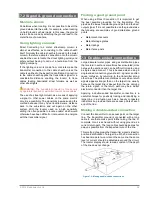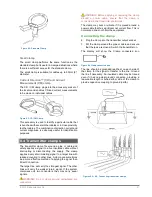
© 2015 Radiodetection Ltd
32
NOTE: It is not necessary to make a ground connection
from the transmitter when using the clamp.
Transmitter clamp range
Although transmitter and locator clamps look the same,
they have different internal windings. To prevent the
wrong clamp being connected, transmitters and locator
clamps have plugs of a different orientation.
Standard signal clamps
The standard clamps apply the transmitter signal very
selectively and effectively to a target cable up to 130mm
(
5¼”) in diameter using frequencies from 8kHz to
200kHz
The standard and small clamps have a double spring
action for positive toroidal contact.
Small signal clamp
The small signal clamp is useful for applying signals from
8kHz to 200kHz to a target cable in a pedestal or other
place with limited space. The clamp is suitable for cables
up to 50mm diameter.
Current Direction (CD) clamp
The CD clamp plugged into the accessory socket of the
transmitter enables CD signals to be applied to individual
cables.
WARNING!. The transmitter must only be connected
to live services using the appropriate accessory such as
a plug connector or live cable connector.
8.5 Sondes
Sonde overview
A sonde is a self-contained battery operated transmitter
used for tracing the paths of pipes, ducts, sewers and
drains and in the precise location of blockages or
collapses. The sonde can be fitted to a flexible rod for
insertion or pushing through pipes etc. and the smaller
diameter sondes can be used in conjunction with jetting
machines and blown through the duct. A suitable
Radiodetection locator can then be used to locate the
sonde
Choosing a suitable sonde
Radiodetection offers a wide range of sonde to suit most
applications: From the
¼” / 6 mm diameter S6 33kHz
microsonde which, with a range of
6.6” / 2m, targets
fiber-optic micro ducting or other small non-conductive
pipes, to the 33kHz Super Sonde, which with a depth
range of 50 feet / 15m targets deep sewer pipes.
Consult the precision locate accessory range brochure
or web page on
www.radiodetection.com
for a full list of
all available sondes and their technical specifications.
Check that the sonde has sufficient range for the
application and is dimensionally small enough and
sufficiently robust for the application. Ensure that the
frequency of the sonde corresponds with the locator
frequency; the locator will not locate the sonde unless
the frequencies are the same. Sondes are marked with
their transmitting frequency. Ensure that the means of
propelling the sonde is available together with the
correct fittings and couplings.
Preparation
Insert a new battery into the sonde. A new battery or a
freshly recharged battery should be used at the
beginning of each day and preferably at the start of each
new job.
Before inserting the sonde, check that the sonde and
locator are at the same frequency and working correctly.
To do this, place the sonde on the ground at a distance
from the locator that is equal to the rated depth of the
sonde. Point the locator at the sonde with the antenna in
line with the sonde (the opposite of using the locator to
locate a line) and check that the bargraph reading
exceeds 50% at maximum sensitivity.
Propelling a sonde
Sondes have a thread at one end for connecting to drain
rods, or to other devices for inserting and propelling the
sonde along a drain or duct. Sondes may be floated
along drains at the end of a tether and floats are
available for fitting to the sewer sonde and super sonde.
Sondes can be strapped to high-pressure water jets or
similar devices used for cleaning, maintaining and
inspecting drains. Sondes used in underground drilling
and boring operations are normally housed in the boring
or drill head behind the boring or drill bit.
Locating and tracing a sonde
Insert the sonde in the drain or duct access and locate it
while it is still just in view at the drain or duct entrance.
Hold the locator vertical directly over the sonde with the
antenna in line with the sonde. Adjust the locator
sensitivity so the bar graph reads between 60% and
80%.
Figure 8.7: CD clamp




































